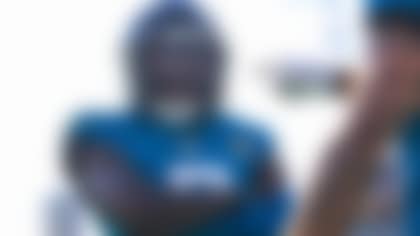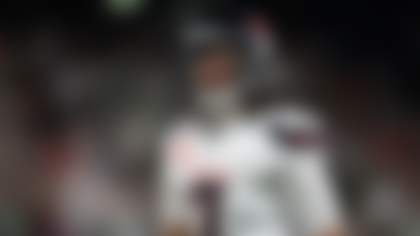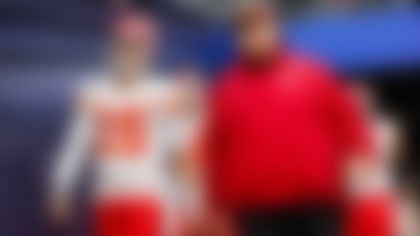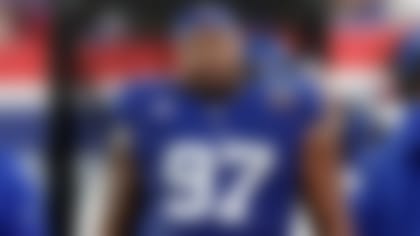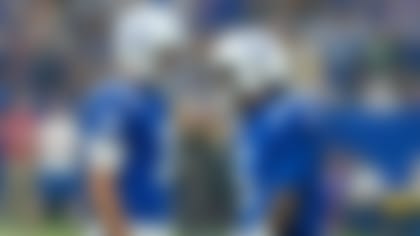Former NFL player and scout Bucky Brooks knows the ins and outs of this league, providing keen insight in his notebook. The topics of this edition include:
But first, a look at one of the league's most enticing storylines heading into Week 1 ...
Perhaps Kyle Shanahan was simply having fun calling plays during the 49ers' preseason finale, but the thought of the offensive wizard employing a two-quarterback system in San Francisco should make defensive coordinators around the league shake in their boots.
The Niners rotated ´╗┐Jimmy Garoppolo´╗┐ and rookie Trey Lance during the first couple of series in the game against the Las Vegas Raiders, with each signal-caller scoring a touchdown. San Francisco's unorthodox approach -- and, let's be honest, this new extended walk-up to the regular season -- has imaginations running wild across the football world. Predictably, Shanahan's in no hurry to provide clarity before the real games begin. In fact, he still won't even name a starter.
"I don't need to announce the quarterback," Shanahan said. "I don't think I need to announce the starting punt returner, either, but I bet you guys could figure it out."
Now, this two-QB system didn't just appear out of thin air last Sunday. Shanahan with The MMQB's Albert Breer back in early August. And in his Friday media availability before San Francisco's preseason finale, the 41-year-old offensive guru explained why San Francisco continues to tinker with its plan at the game's most important position.
"," Shanahan said, in reference to a potential two-QB system utilizing Garoppolo and Lance. "Seeing what they're good at, what they can help us with on the team, how to balance stuff out, and that's why we are practicing everything. I've never been in a situation where I had a skill set where I had two guys like that you could practice it, and that's what we're finding out."
Although QB timeshares have rarely been utilized in the NFL, the 49ers' willingness to feature Garoppolo and Lance as co-QB1s could create an offensive juggernaut that'd be an absolute nightmare to defend. I am not trying to engage in hype wars when I make this proclamation, but it is impossible to ignore the headaches that Shanahan could generate with each of his field generals playing a prominent offensive role. San Francisco could seamlessly shift from a traditional offense to a college-like read-option system that tests the discipline, awareness and football IQ of every defender on the field. In addition, the athleticism of each quarterback would enable Shanahan to blur the lines when it comes to preparing for the offense. For instance, Garoppolo is athletic enough to execute an occasional zone-read play with the quarterback keeping the rock against an overaggressive defensive end. And Lance is a competent passer capable of making accurate throws on the bootleg-heavy misdirection/movement passing game that is a staple of the Niners' scheme.
Shanahan already has experience developing a multi-faceted system that meshes his traditional scheme with an attack that features more collegiate concepts. As the offensive coordinator under his dad in Washington, he crafted game plans that accommodated ´╗┐Robert Griffin III´╗┐ and ´╗┐Kirk Cousins´╗┐. Considering each player produced in his specialized offense, it is quite possible Shanahan could pull this off in San Francisco.
In fact, I am rooting for Shanahan to experiment with the two-quarterback approach. Not only would this unusual strategy be fascinating to watch, but it could perfectly suit the rest of San Francisco's unique offensive personnel. From their hybrid studs on the TE/FB front (´╗┐George Kittle´╗┐ and ´╗┐Kyle Juszczyk´╗┐) to their explosive wing backs (´╗┐Deebo Samuel´╗┐ and ´╗┐Brandon Aiyuk´╗┐) to their stable of rock-solid runners (´╗┐Raheem Mostert´╗┐, Trey Sermon, and ´╗┐JaMycal Hasty´╗┐), the Niners can hit opponents with a hodgepodge of playmakers who make it difficult for defensive coordinators to take away any one key component of the offense. With Shanahan adding a dizzying array of motions and shifts to the mix, San Francisco applies major stress on the opposition to identify personnel and match specific plays to players.
To repeat, last Sunday's display could have just been Shanahan messing around in the preseason and putting something frightening on tape. (Can you imagine being this brand new Detroit Lions regime, preparing to host San Francisco in the season opener? Lotta sleepless nights in Motown, this week and next.)
But then again, Shanahan is one of the most creative play callers in the game today. Maybe this is his new wrinkle. Maybe he's preparing to unfurl some organized chaos that could flip the league on its head. And if so, I'm here for it!
JAMEIS WINSTON: New QB1 changes Saints' attack
I was not surprised to see ´╗┐Jameis Winston´╗┐ emerge from a closely watched quarterback battle with ´╗┐Taysom Hill´╗┐ as the New Orleans Saints' QB1.
Despite the narrative surrounding his game, the former No. 1 overall pick is an A-level talent with the football IQ and big arm to play at a high level in this league. He is one of only eight quarterbacks in NFL history to pass for 5,000 yards in a single season. And in that particular season -- 2019, Winston's last in Tampa and last as a starter -- he finished second in the league with 33 touchdown passes. Sure, the naysayers will point out that he also piled up a whopping 35 turnovers that year, becoming the first member of the "30-30 club." Still, to me, there's no denying his talent and potential as a QB1. Not to mention, the 27-year-old already has 70 NFL starts under his belt. I'm quite intrigued to see what he can accomplish while working with one of the NFL's best play callers in Sean Payton.
"The No. 1 thing is leading your offense, moving the ball and scoring points," the Saints head coach said, , after naming Winston the starter. "We feel like he's got a unique skill set with his arm talent."
Studying the Saints over the past few years, the team increasingly played small ball with ´╗┐Drew Brees´╗┐ under center. To be clear: No. 9 is a no-doubt Hall of Famer. But down the stretch of his illustrious career, Brees' arm noticeably eroded. Winston's ability to push the down the field will give this offense a dimension it's been missing for a while now. From throwing the deep ball over the top of the defense to pushing the ball to the boundary on deep comebacks, New Orleans' new QB1 will enable Payton to stretch the field vertically and horizontally. In 2019, according to Next Gen Stats, Winston ranked second among NFL passers in both average completed air yards (8.2) and average intended air yards (10.5).
This kind of downfield passing threat could result in ´╗┐Alvin Kamara´╗┐ seeing fewer loaded boxes and plus-one defensive fronts. Considering how the perennial Pro Bowler is able to slither through cracks and elude defenders in space, the Saints' ability to remove safeties from the box could enable the offense to utilize a more balanced approach.
If Winston can take care of the football and avoid risky plays, he can take this offense to the next level. The seventh-year pro simply needs to put a lesson that he learned from his predecessor into practice.
"Just being able to execute and do my job, and that's something I've learned from Drew," . "Be Bruce Wayne until you have to be Batman. You don't have to be Batman all the time."
If Winston heeds Brees' advice, the Saints can continue to roll as an annual contender in the NFC.
ALABAMA: The new QBU?
Nick Saban has created college football's premier football factory at Alabama. While most of the prized prospects who have mastered as members of the Crimson Tide are defenders, running backs or wide receivers, Saban is quietly becoming one the college game's top quarterback whisperers. Need proof? How about the three former Saban pupils -- the Eagles' Jalen Hurts (who spent his final college season at Oklahoma after three years with the Tide), Patriots' Mac Jones and Dolphins' Tua Tagovailoa -- opening the 2021 NFL season as Week 1 starters?
For old-school scouts, the thought of Alabama emerging as QBU is hard to fathom, given the many caretakers who served as the program's starting quarterback in the past. But Hurts, Jones and Tagovailoa have a chance to alter the perception of Crimson Tide signal-callers in league circles.
Hurts and Tagovailoa are routinely dismissed by some who question their status as legitimate QB1s. I'm not sure that's fair, given how they both provided a spark as rookies last season, with Tua compiling a 6-3 record. Still, the second-year pros are on the hot seat to perform in 2021 or risk losing their respective jobs. Jones steps into a different situation after dispatching a former MVP (Cam Newton) in a quarterback competition to fill a role previously occupied by the G.O.A.T. (Tom Brady). The rookie must convince the skeptics that he can win at a high level while evolving from a game manager to a playmaker early in his career. Although he displayed composure and confidence throughout the preseason, questions persist regarding his skills and superpowers compared to his peers.
Instead of viewing Saban's former QB1s as trailers who rely on an extraordinary supporting cast to carry them to the winner's circle, the Crimson Tide alums could show the football world that they are trucks with the potential to carry flawed teams to victory.
In scouting circles, evaluators can fall into the trap of scouting the helmet (prejudging players based on the performance of their predecessors at the position from the same school) instead of basing evaluations on individual performances. Given that a former Alabama QB hasn't made the Pro Bowl since the 1970s, the scouting world is paying close attention to Hurts, Tagovailoa and Jones in 2021. Will they force evaluators to more readily embrace future QB prospects from Saban's powerhouse program or allow some scouts to proceed with skepticism when it comes to 'Bama passers?
UDFAs: Making presence felt on initial rosters
If I were a general manager or personnel director in the NFL, I would be urging my college scouts to spend more time on the road looking for hidden gems and underrated prospects with prototypical height-weight-speed characteristics or a few blue-chip qualities that could enable them to succeed in the league.
While most evaluators consider these factors when assessing prospects, there are so many undrafted players making NFL rosters that something is clearly missing in the scouting process.
There were 415 former undrafted free agents on initial 53-man rosters for the 32 NFL teams this week, . Considering 562 former Day 3 picks (Rounds 4-7) made it through the round of final cuts, the gap between draftees and free agents is closer than it has ever been before.
Perhaps teams are utilizing a more meritocratic approach, with the best players making the squad regardless of draft status. Instead of holding on to players due to their draft grades and/or the fear of admitting to a blown pick, some evaluators could be opting to keep unheralded players who outplay their competitors in position battles. Despite getting fewer reps in practice and starting out at the bottom of the depth chart, undrafted free agents appear to be making the most of their opportunities in a league that is increasingly rewarding them for their efforts.
"It is harder to project which players will pop at the next level due to the drastic differences between the college and pro game," an NFC personnel director recently told me. "Just because a guy is a draft pick does not guarantee a quick transition to the NFL. Some guys grasp the concepts and overall game better than others, and you have to be willing to let those guys have the chance to play."
To that point, I'm seeing more teams make a concerted effort to attract undrafted free agents by offering them real opportunities to make the team. Those offers often do not include significant signing bonuses or guarantees, but rather a willingness to let them really compete for jobs. The Ravens, Seahawks, Patriots and others have a long history of playing undrafted free agents, and their track record appeals to agents and players looking for a chance to make a mark in the NFL despite entering the league with little fanfare.
Part of the recent success of undrafted free agents can be attributed to coaches investing legit time, energy and instruction. Coaches must demonstrate a willingness to develop all of the players on the roster without bias, giving everyone a chance to prove their worth on the field in game action and team drills. Moreover, the head coach must be committed to the process. He needs to encourage his assistants to monitor the development of the younger guys and elevate those players on the depth chart who perform to the standard.
Without a total buy-in from the coaches, the process fails to produce hidden gems and teams miss out on a chance to add an unheralded player who could become a key contributor. Given the number of former undrafted free agents making 53-man rosters in 2021, it's time for scouts and coaches to take a closer look at some of the so-called misfits who are simply looking for a shot to make it big.
Follow on Twitter.



